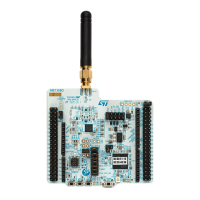RM0453 Rev 5 953/1450
RM0453 Low-power timer (LPTIM)
972
If the Continuous mode was previously selected, setting SNGSTRT switches the LPTIM to
the One-shot mode. The counter (if active) stops as soon as an LPTIM update event is
generated.
If the One-shot mode was previously selected, setting CNTSTRT switches the LPTIM to the
Continuous mode. The counter (if active) restarts as soon as it reaches ARR.
28.4.9 Timeout function
The detection of an active edge on one selected trigger input can be used to reset the
LPTIM counter. This feature is controlled through the TIMOUT bit.
The first trigger event starts the timer, any successive trigger event resets the LPTIM
counter and the repetition counter and the timer restarts.
A low-power timeout function can be realized. The timeout value corresponds to the
compare value; if no trigger occurs within the expected time frame, the MCU is waked-up by
the compare match event.
28.4.10 Waveform generation
Two 16-bit registers, the LPTIM_ARR (autoreload register) and LPTIM_CMP (compare
register), are used to generate several different waveforms on LPTIM output
The timer can generate the following waveforms:
• The PWM mode: the LPTIM output is set as soon as the counter value in LPTIM_CNT
exceeds the compare value in LPTIM_CMP. The LPTIM output is reset as soon as a
match occurs between the LPTIM_ARR and the LPTIM_CNT registers.
• The One-pulse mode: the output waveform is similar to the one of the PWM mode for
the first pulse, then the output is permanently reset
• The Set-once mode: the output waveform is similar to the One-pulse mode except that
the output is kept to the last signal level (depends on the output configured polarity).
The above described modes require that the LPTIM_ARR register value be strictly greater
than the LPTIM_CMP register value.
The LPTIM output waveform can be configured through the WAVE bit as follow:
• Resetting the WAVE bit to ‘0’ forces the LPTIM to generate either a PWM waveform or
a One pulse waveform depending on which bit is set: CNTSTRT or SNGSTRT.
• Setting the WAVE bit to ‘1’ forces the LPTIM to generate a Set-once mode waveform.
The WAVPOL bit controls the LPTIM output polarity. The change takes effect immediately,
so the output default value changes immediately after the polarity is re-configured, even
before the timer is enabled.
Signals with frequencies up to the LPTIM clock frequency divided by 2 can be generated.
Figure 267 below shows the three possible waveforms that can be generated on the LPTIM
output. Also, it shows the effect of the polarity change using the WAVPOL bit.

